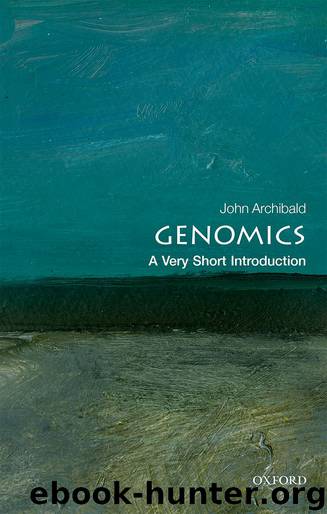Genomics by John M. Archibald

Author:John M. Archibald
Language: eng
Format: epub, mobi
ISBN: 9780191089480
Publisher: OUP Oxford
Published: 2018-01-10T16:00:00+00:00
Population genomics of Adam and Eve
One of the first and most contentious applications of a DNA-based molecular clock was to better understand the evolution of our own species. Here the bacterial-like DNA found in the mitochondrion has proven extremely useful. Recall that the Y chromosome is unique to men, and mitochondria, though present in both males and females, are maternally inherited. Consequently, the probability that the mitochondrial and (if present) Y-chromosomal genotypes of any specific individual will persist for extended periods of time in a population is heavily influenced by the random nature of genealogy. Researchers have coined the terms ‘Y-chromosome Adam’ and ‘Mitochondrial Eve’ to refer to the most recent common ancestors of these two distinct genetic components of the human genome, and, as we shall see, comparative genomics has been used to trace these ancestors back in time. Counterintuitive though it may seem, Adam and Eve need not have existed at the same time or in the same place.
The age of Mitochondrial Eve has remained relatively stable since it was first predicted in a landmark study published in 1987 by the New Zealand-born University of California (Berkeley) geneticist Allan Wilson and colleagues. Wilson’s team used a molecular-clock approach to estimate that the mitochondrial DNAs of all modern humans trace back to a single woman living in Africa roughly 200,000 years ago. Using similar methodologies, Y-chromosome Adam was initially predicted to be a good deal younger: the common ancestor of the non-recombining portion of the Y-chromosome passed from fathers to sons was inferred to have lived ~100,000 years before the present. With the accumulation of more genomic data from geographically diverse males, however, Adam’s age has been pushed further back to between 200,000 to 300,000 years ago.
These numbers do not mean that at specific points in time humanity was represented by a single living man and/or woman. Y-chromosome Adam and Mitochondrial Eve were simply individuals within their respective human populations to which all of the Y chromosome sequences and mitochondrial DNAs of present-day humans happen to trace. Maternally inherited mitochondrial DNAs and, in males, paternally derived Y chromosomes must obviously be passed on with each generation, but the genotype of any single human being is subject to extinction, the chances of which are elevated as a result of population bottlenecks (which are known to have occurred at various times during human evolution) (see Figure 12). The further back in time one goes, the number of ancestral genotypes that modern human genotypes can conceivably trace back to becomes smaller and smaller. At any point in time, there can be only one Y-chromosome Adam and Mitochondrial Eve, and their genealogies appear to be very different. The ages and identities of Adam and Eve are in fact not fixed but will change as human populations continue to evolve, and different maternal and paternal lineages go extinct.
12. Maternal inheritance of human mitochondria and mitochondrial DNA (mtDNA). Black shows the maternal line that traces from the present back seven generations to the mtDNA most recent common ancestor.
Download
This site does not store any files on its server. We only index and link to content provided by other sites. Please contact the content providers to delete copyright contents if any and email us, we'll remove relevant links or contents immediately.
| Cell Biology | Developmental Biology |
| Entomology | Marine Biology |
| Microbiology | Molecular Biology |
| Biostatistics |
Sapiens: A Brief History of Humankind by Yuval Noah Harari(14252)
The Tidewater Tales by John Barth(12608)
Mastermind: How to Think Like Sherlock Holmes by Maria Konnikova(7227)
Do No Harm Stories of Life, Death and Brain Surgery by Henry Marsh(6891)
The Thirst by Nesbo Jo(6826)
Why We Sleep: Unlocking the Power of Sleep and Dreams by Matthew Walker(6618)
Life 3.0: Being Human in the Age of Artificial Intelligence by Tegmark Max(5474)
Sapiens by Yuval Noah Harari(5294)
The Longevity Diet by Valter Longo(5019)
The Body: A Guide for Occupants by Bill Bryson(4974)
The Rules Do Not Apply by Ariel Levy(4861)
The Immortal Life of Henrietta Lacks by Rebecca Skloot(4525)
Animal Frequency by Melissa Alvarez(4395)
Why We Sleep by Matthew Walker(4360)
The Hacking of the American Mind by Robert H. Lustig(4318)
Yoga Anatomy by Kaminoff Leslie(4306)
All Creatures Great and Small by James Herriot(4232)
Double Down (Diary of a Wimpy Kid Book 11) by Jeff Kinney(4207)
Barron's AP Biology by Goldberg M.S. Deborah T(4097)
